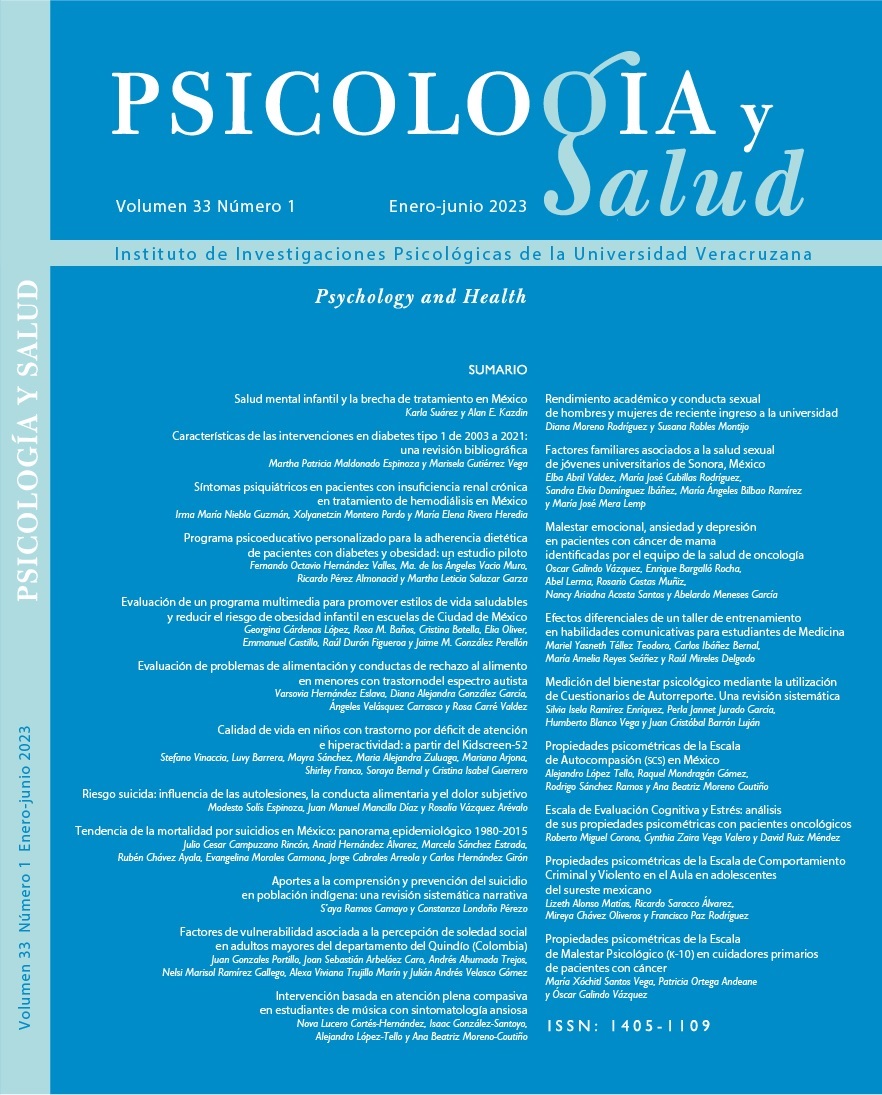Abstract
Objective. To explore the acquired capacity to commit suicide, the influence of disordered eating behavior (DEB), self-harm, and subjective pain on the suicidal risk of adolescents. Method. An online survey obtained a sample of 423 young women, in which DEB, suicide risk, depressive symptoms, and self-harm were evaluated. Two one-way ANOVA and post hoc tests analyzed the differences between control groups, with self-harm, with DEB, and with both problems regarding suicide risk and depressive symptoms. Likewise, two one-way ANOVA and post hoc tests compared groups with different degrees of subjective pain after self-injury. Results. The comorbid group and the pain habituation group showed higher scores but did not differ significantly in all the groups. Conclusions. Cases with comorbidity require special attention, as well as those adolescents with self-injury who may become accustomed to pain.
References
Ammerman, B.A., Burke, T.A., Alloy, L.B. y McCloskey, M.S. (2016). Subjective pain during NSSI as an active agent in suicide risk. Psychiatry Research, 236, 80-85. Doi: 10.1016/j.psychres.2015.12.028.
Beck, A.T., Steer, R.A., Ball, R. y Ranieri, W. (1996). Comparison of Beck Depression Inventory-IA and -II in psychiatric outpatients. Journal of Personality Assessment, 67, 588-597. Doi: 10.1207/s15327752jpa6703_13.
Brausch, A.M. y Perkins, N.M. (2018). Nonsuicidal self-injury and disordered eating: Differences in acquired capability and suicide attempt severity. Psychiatry Research, 266, 72-78. Doi: 10.1016/j.psychres.2018.05.021.
Chung, D.T., Ryan, C.J., Hadzi-Pavlovic, D., Singh, S.P., Stanton, C. y Large, M.M. (2017). Suicide rates after discharge from psychiatric facilities: a systematic review and meta-analysis. JAMA Psychiatry, 74(7), 694-702. Doi: 10.1001/jamapsychiatry.2017.1044.
Garner, D.M. y Garfinkel, P.E. (1979). The Eating Attitudes Test: An index of the symptoms of anorexia nervosa. Psychological Medicine, 9, 273-279. Doi: 10.1017/s0033291700030762.
Hasking, P., Lewis, S.P., Bloom, E., Brausch, A., Kaess, M. y Robinson, K. (2021). Impact of the COVID-19 pandemic on students at elevated risk of self-injury: The importance of virtual and online resources. School Psychology International, 42(1), 57-78. Doi: 10.1177%2F0143034320974414.
Hernández R., J. (2020). Impacto de la COVID-19 sobre la salud mental de las personas. Medicentro Electrónica, 24(3).
Hubers, A., Moaddine, S., Peersmann, S., Stijnen, T., van Duijn, E., van der Mast, R.C., Dekkers, O.M. y Giltay, E.J. (2018). Suicidal ideation and subsequent completed suicide in both psychiatric and non-psychiatric populations: a meta-analysis. Epidemiology and Psychiatric Sciences, 27(2), 186-198. Doi: 10.1017/S2045796016001049.
Islam, M.A., Steiger, H., Jiménez M., S., Israel, M., Granero, R., Agüera, Z., Castro, R., Sánchez, I., Riesco, N., Menchón, J.M. y Fernández A., F. (2015). Non-suicidal self-injury in different eating disorder types: relevance of personality traits and gender. European Eating Disorders Review, 23(6), 553-560. Doi: 10.1002/erv.2374.
Joiner, T. (2005). Why people die by suicide. Cambridge, MA: Harvard University Press.
Jurado, S., Villegas, M.E., Méndez, L., Rodríguez, F., Loperena, V. y Varela, R. (1998). La estandarización del Inventario de Depresión de Beck para los residentes de la Ciudad de México. Salud Mental, 21, 26-31.
Kostro, K., Lerman, J.B. y Attia, E. (2014). The current status of suicide and self-injury in eating disorders: a narrative review. Journal of Eating Disorders, 2(19), 1-9. Doi: 10.1186/s40337-014-0019-x.
Ma, J., Batterham, P.J., Calear, A.L. y Han, J. (2016). A systematic review of the predictions of the interpersonal-psychological theory of suicidal behavior. Clinical Psychology Review, 46, 34-45. Doi: 10.1016/j.cpr.2016.04.008.
O’Connor, R., Wetherall, K., Cleare, S., McClelland, H., Melson, A., Niedzwiedz, C. y Robb, K. (2020). Mental health and well-being during the COVID-19 pandemic: Longitudinal analyses of adults in the UK COVID-19 Mental Health y Wellbeing study. The British Journal of Psychiatry, 218(6), 326-333. Doi: 10.1192/bjp.2020.212.
Plutchick, R. y Van Praag, H. (1989). The measurement of suicidality, aggressivity and impulsivity. Progress in Neuro-Psychopharmacolology, Biology and Psychiatry, 6(13), 523-534. Doi: 10.1016/0278-5846(89)90107-3.
Prati, G. y Mancini, A.D. (2021). The psychological impact of COVID-19 pandemic lockdowns: A review and meta-analysis of longitudinal studies and natural experiments. Psychological Medicine, 51(2), 201-211. Doi: 10.1017/S0033291721000015.
Rubio, G., Montero, I., Jáuregui, J., Villanueva, R., Casado, M., Marín, J.J. y Santo-Domingo, J. (1998). Validación de la Escala de Riesgo Suicida de Plutchik en población española. Archivos de Neurobiología, 61(2), 143-152.
Smith, A.R., Ortiz, S.N., Forrest, L.N., Velkoff, E.A. y Dodd, D.R. (2018). Which comes first? An examination of associations and shared risk factors for eating disorders and suicidality. Current Psychiatry Reports, 20, 77. Doi: 10.1007/s11920-018-0931-x.
Sociedad Mexicana de Psicología (2007). Código ético del psicólogo (4a. ed.). México: Trillas.
Solís E., M. y Gómez-Peresmitré, G. (2020). Cuestionario de Riesgo de Autolesión (CRA): propiedades psicométricas y resultados en una muestra de adolescentes. Revista Digital Internacional de Psicología y Ciencia Social, 6(1). Doi: 10.22402/j.rdipycs.unam.6.1.2020.206.123-141.
Suárez C., Y., Palacio S., J., Caballero D., C.C. y Pineda R., C.A. (2019). Adaptación, validez de constructo y confiabilidad de la Escala de Riesgo Suicida de Plutchik en adolescentes colombianos. Revista Latinoamericana de Psicología, 51(3), 145-152. Doi: 10.14349/rlp.2019.v51.n3.1.
Svirko, E. y Hawton, K. (2007). Self-injurious behavior and eating disorders: the extent and nature of the association. Suicide & Life-threatening Behavior, 37(4), 409-421. Doi: 10.1521/suli.2007.37.4.409.
Taquet, M., Luciano, S., Geddes, J.R. y Harrison, P.J. (2021). Bidirectional associations between COVID-19 and psychiatric disorder: retrospective cohort studies of 62 354 COVID-19 cases in the USA. The Lancet Psychiatry, 8(2), 130-140. Doi: 10.1016/S2215-0366(20)30462-4.
Witte, T.K., Zuromski, K.L., Gauthier, J.M., Smith, A.R., Bartlett, M., Siegfried, N., Bodell, L. y Goodwin, N. (2016). Restrictive eating: Associated with suicide attempts, but not acquired capability in residential patients with eating disorders. Psychiatry Research, 235, 90-96. Doi: 10.1016/j.psychres.2015.11.043.

